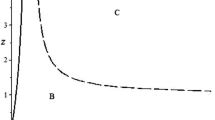Abstract
Studies of optimal second-best environmental regulation of identical polluting agents have invariably ignored potentially welfare-improving asymmetric regulation by imposing equal regulatory treatment of identical firms at the outset. Yet, cost asymmetry between oligopoly firms may well give rise to private as well as social gains. A trade-off is demonstrated for the regulator, between private costs savings and additional social costs when asymmetric treatment is allowed. Asymmetry is indeed optimal for a range of plausible parameter values. Further, it is demonstrated that for a broad class of abatement cost functions, there is scope for increasing welfare while keeping both total output and total emission constant. Some motivating policy issues are discussed in light of the results, including international harmonization and global carbon dioxide reduction.
Similar content being viewed by others
References
R. Amir (1996) ArticleTitle‘Cournot Oligopoly and the Theory of Supermodular Games’ Games and Economic Behavior 15 132–148
R. Amir V.E. Lambson (2000) ArticleTitle‘On the Effects of Entry in Cournot Markets’ Review of Economic Studies 67 235–254
T.C. Bergstrom H.R. Varian (1985a) ArticleTitle‘Two Remarks on Cournot Equilibria’ Economic Letters 19 5–8
T.C. Bergstrom H.R. Varian (1985b) ArticleTitle‘When are Nash Equilibria Independent of the Distribution of Agents’ Characteristics?’ Review of Economic Studies 52 715–718
P.G. Frederiksson (1997) ArticleTitle‘The Political Economy of Pollution Taxes in a Small Open Economy’ Journal of Environmental Economics and Management 33 44–58
N.V. Long A. Soubeyran (1997) Greater Cost Dispersion Improves Oligopoly Profits: Asymmetric Contributions to Joint Ventures JA Poyago-Theotoky (Eds) Competition, Cooperation, and RD The Economics of Research Joint Ventures Macmillan London 126–137
NV Long A Soubeyran (1999) ArticleTitleAsymmetric Contributions to Research Joint Ventures Japanese Economic Review 50 122–137
Long, N.V. and Soubeyran, A. (2001), ‘Cost Manipulation Games in Oligopoly, with Costs of Manipulating’, International Economic Review 42(2).
Long, N.V. and Soubeyran, A. (2002), Selective Penalization of Polluters: An Inf-Convolution Approach, Série Scientifique, Cirano, Montreal, 2002s–40.
N. Nannerup (2001) ArticleTitle‘Equilibrium Pollution Taxes in a Two Industry Open Economy’ European Economic Review 45 519–532
S.W. Salant G.E. Shaffer (1998) ArticleTitle‘Optimal Asymmetric Strategies in Research Joint Ventures’ International Journal of Industrial Organisation 16 IssueID2 195–208
S.W. Salant G.E. Shaffer (1999) ArticleTitle‘Unequal Treatment of Identical Agents in Cournot Equilibrium’ American Economic Review 89 585–604 Occurrence Handle10.1257/aer.89.3.585
Author information
Authors and Affiliations
Corresponding author
Rights and permissions
About this article
Cite this article
Amir, R., Nannerup, N. Asymmetric Regulation of Identical Polluters in Oligopoly Models. Environ Resource Econ 30, 35–48 (2005). https://doi.org/10.1007/s10640-004-1044-z
Issue Date:
DOI: https://doi.org/10.1007/s10640-004-1044-z



